Non-venomous spiders dominate the landscape of Arkansas. The state is home to web-weaving and non-weaving spiders of different species.
They can be found in woodlands, prairies, crops, next to lakes or streams, gardens, and homes.
Insects, bugs, small fish, and other spiders are the typical diet of most species around the state.
Table of Contents
Are There Venomous Spiders in Arkansas?
Spiders in Arkansas rarely bite. When they do, it’s mostly as a defense mechanism as they aren’t actively seeking humans.
Most spider bites are harmless. While most spiders have venom, this venom has no impact on humans,
A small number of venomous species may still be found in the state. Spiders such as the Northern Black Widow require medical attention.
The most dangerous type of venom these spiders have contains neurotoxic or necrotic venom.
Brown Recluse spiders in the state have necrotic venom (skin-level lesions) while Northern Black Widows are the species with neurotoxic venom (affects the nervous system).
The following species of non-venomous and venomous spiders are native to Arkansas.
Spiders in Arkansas
1. Yellow Garden Spider
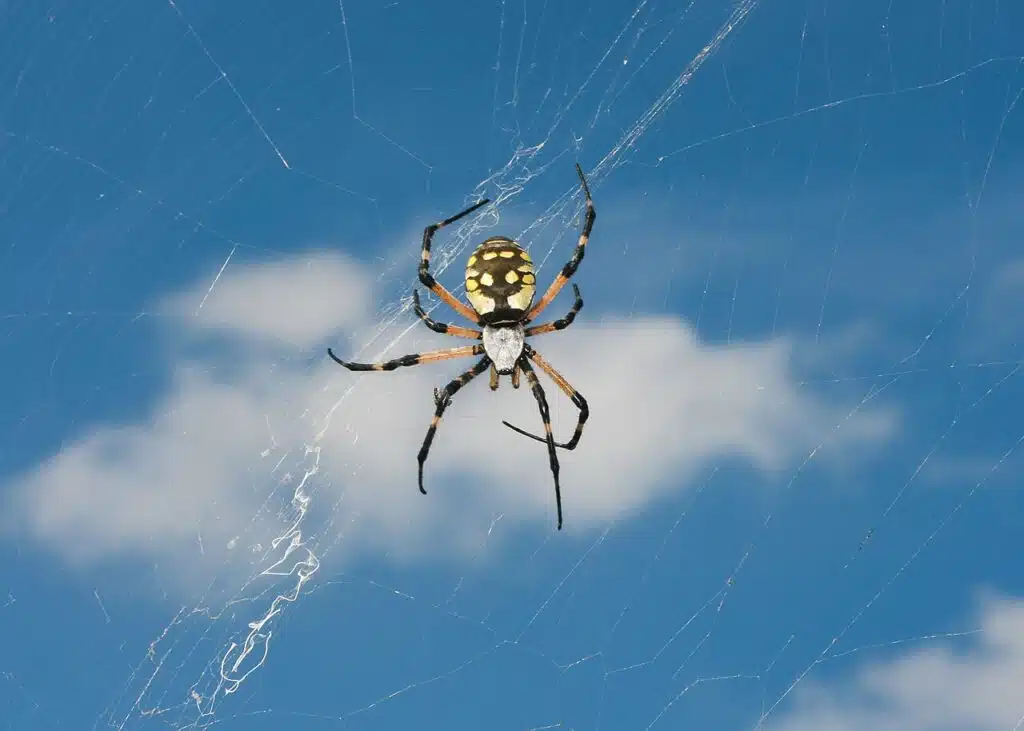
The Yellow Garden Spider (Argiope aurantia) is among the most common species in the state.
Yellow and white are the main colors of the species, together with black. This spider gets its name from the yellow abdomen which is also partly black.
However, the head and face of the species are white.
These large spiders can grow to a maximum size of 28mm in the case of females, as males are smaller.
While common in gardens and somewhat used to human presence, this species might still bite, especially if disturbed.
Yellow Garden Spider bites aren’t dangerous to humans.
2. Spotted Orbweaver
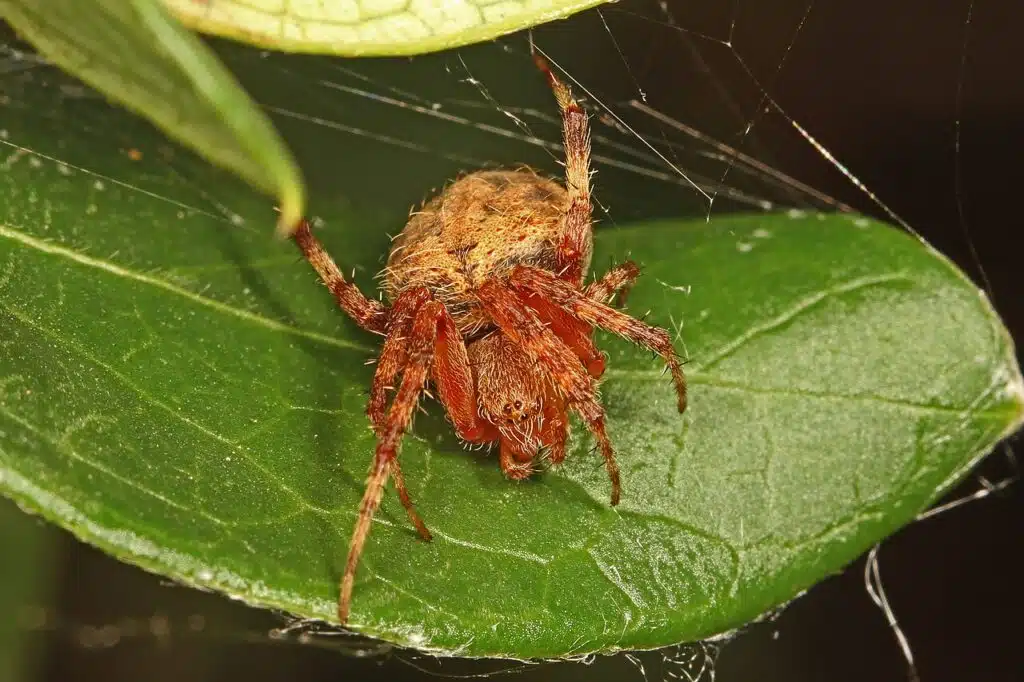
Spotted Orbweaver (Neoscona crucifera) are some of the most common orb-weaving spiders in the state.
This species creates large orb-shaped spider webs that may measure a few feet in diameter.
Variable coloring is specific to the Spotted Orbweaver but a common brown color is mostly associated with this species.
Not seen in the summer, Spotted Orbweavers are nocturnal spiders. They swap to diurnal activity as summer ends and fall begins.
This species also shows a sizing difference between the sexes, as females are larger.
Some of the largest Spotter Orbweaver females measure up to 19mm.
The species has multiple natural predators among wasps.
3. Bold Jumping Spider
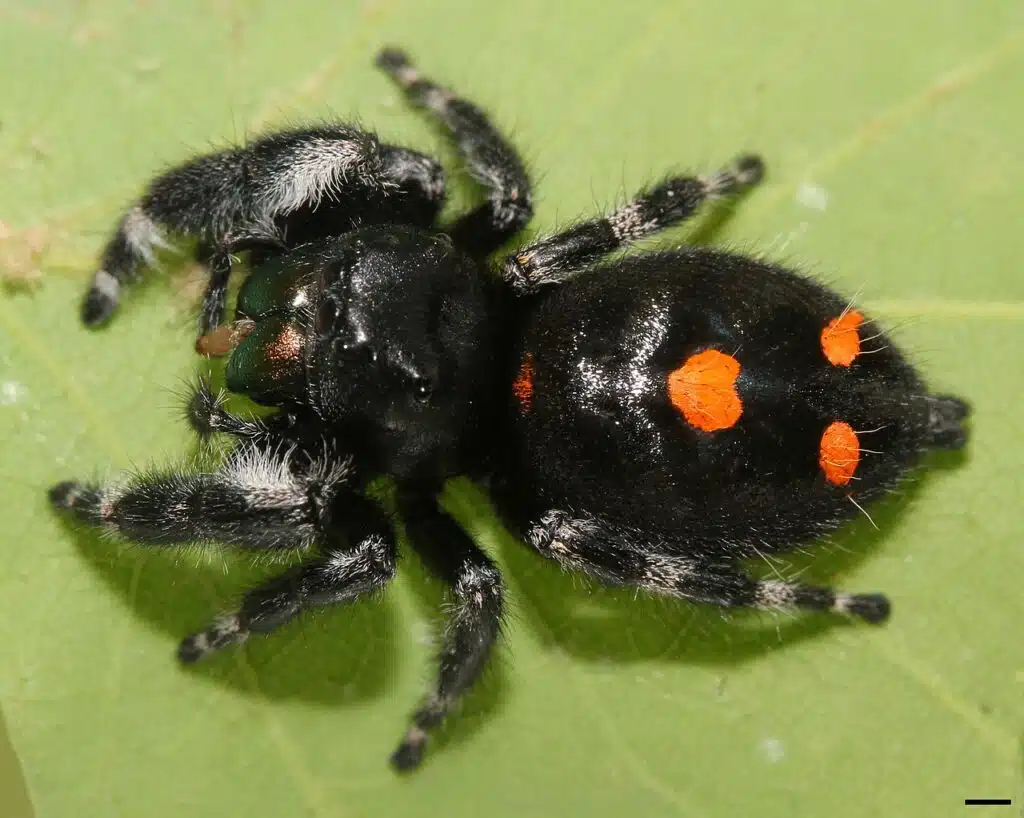
Bold Jumping Spiders (Phidippus audax) are among the most common jumping spiders in Arkansas.
The species is known for having a contrasting appearance, based on black coloring.
Red spots and metallic blue-green mouthparts can be seen on some of these spiders.
Unlike species that build spider webs, the Bold Jumping Spider freely moves around for prey.
It can still produce spider silk, but it only uses it for mating purposes or safety when jumping long distances.
These spiders like to live in open areas where they rely on excellent vision to locate possible prey.
4. Tan Jumping Spider
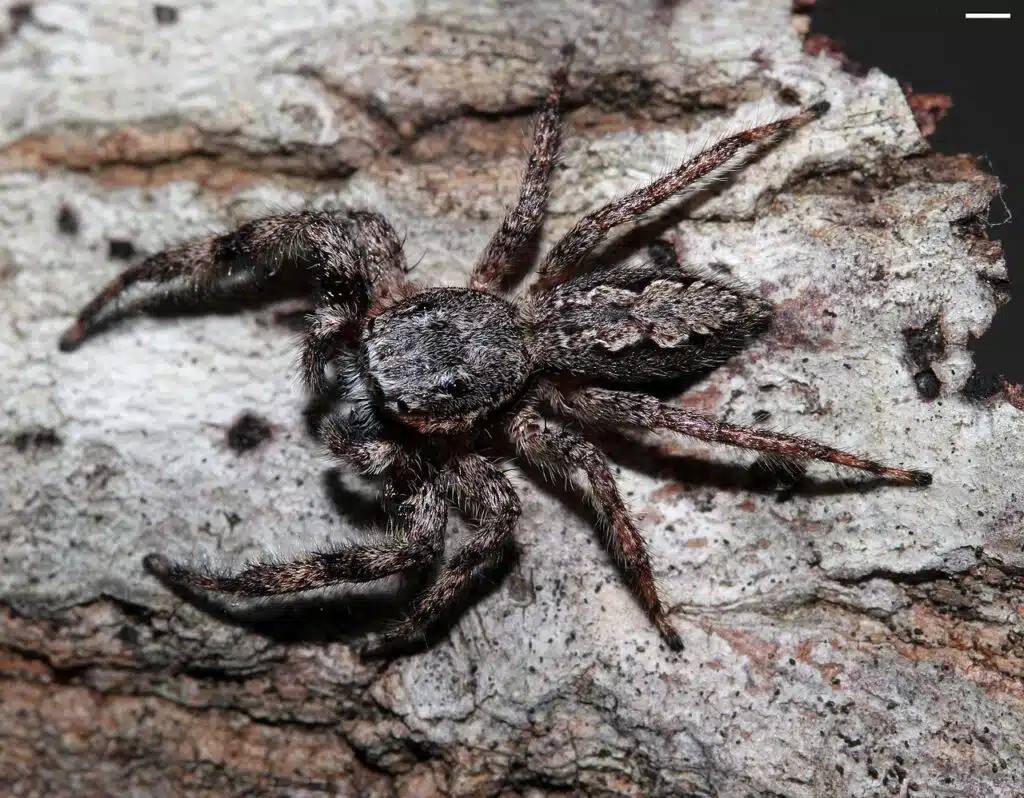
This species of jumping spider (Platycryptus undatus) is slightly smaller than Bold Jumping Spiders.
Tan Jumping Spiders grow up to a size of 13mm with females being larger than males.
While smaller, this spider might seem a bit more common as it likes to live on vertical surfaces and because it has a distinct shape.
The body of the spider has a flatted press-liked look.
Females have a black and gray body while males have a tan to brown body with black and gray secondary colors.
A hairy body and hairy legs are specific to both males and females of the species.
A common sight around homes, Tan Jumping Spiders pose no direct threat to humans as they rarely bite.
5. Green Lynx Spider
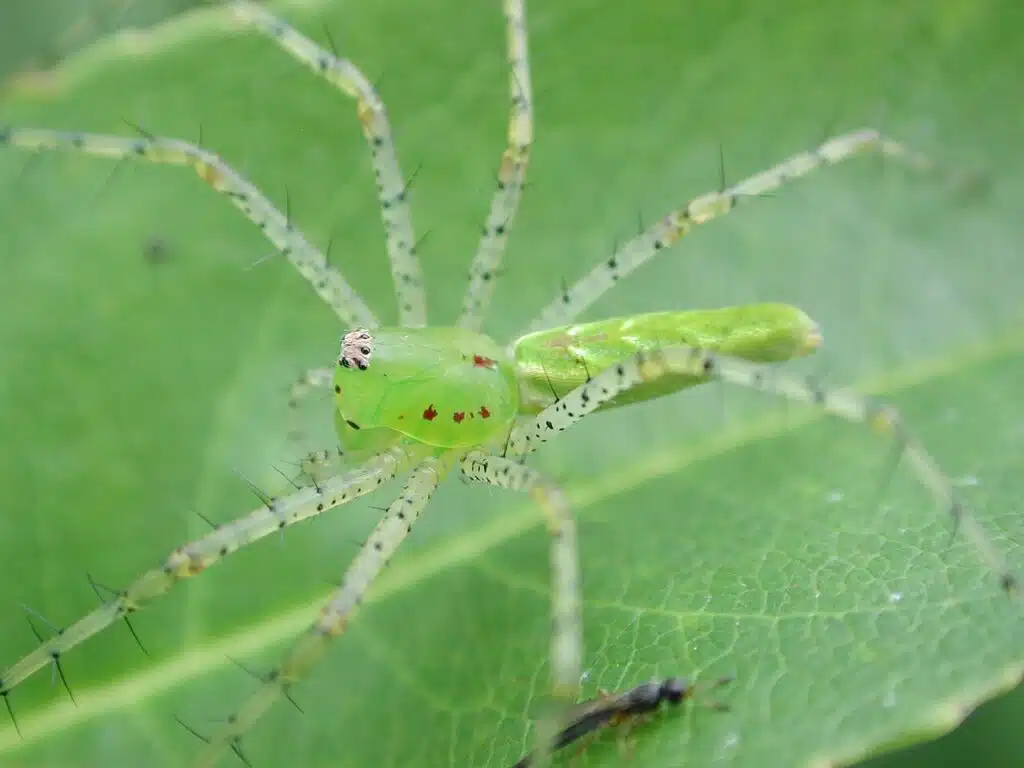
As its name implies, this (Peucetia viridans) is a green spider that spends much of its life on green plants.
It comes with a green body and green or yellow legs.
This spider is a very good predator and it might be considered a beneficial species in some parts of the state.
Its sharp hunting skills make it a natural biocontrol agent for various crop pets. It feeds on various moths and moth larvae which feed on legumes.
This species can also feed on other predator insects and bugs. Wasps might be among its common daily prey as well.
This spider prefers not to bite humans but some bites might still occur yearly. Its venom leads to a swollen bite area, but it doesn’t kill people.
6. Orchard Orbweaver
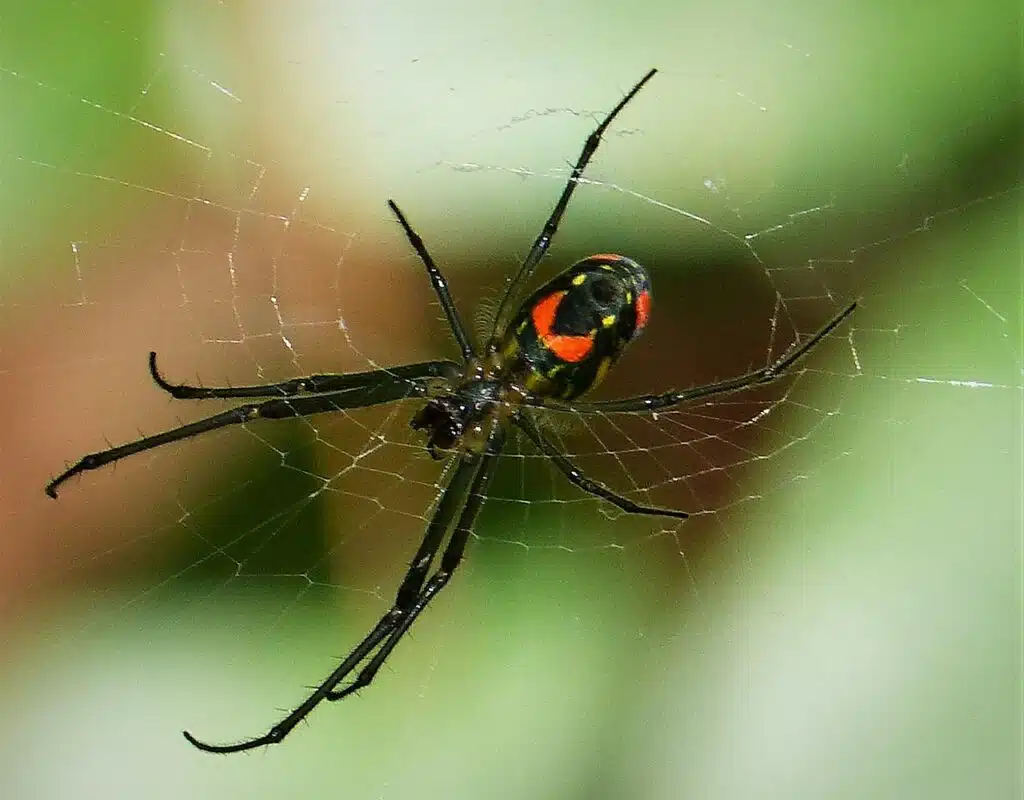
Known for its oversized legs, the Orchard Orbweaver (Leucauge venusta) is a species with long green legs.
This spider has silver, white, green, black, or yellow body coloring.
Its spider web is a common sight in gardens. Horizontal orientation is specific to this spider web.
Its large spider web is used to catch insects. Female Orchard Orweavers are spotted in the central location of the spider web.
Females lay on the underside of the spider web so they can drop to the ground whenever facing dangers such as predators.
One of the most common predators of this spider is the mud dauber wasp, a species that may carry it back to its nest as provision.
7. Southern Black Widow
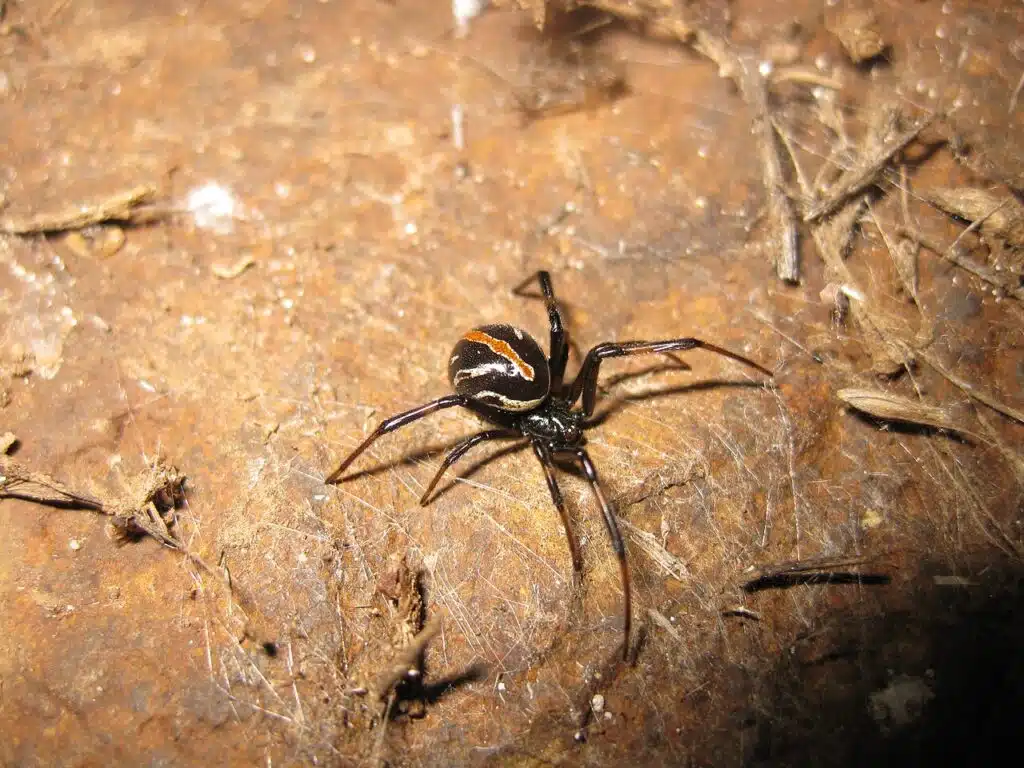
Neurotoxic venom is one of the reasons why the Southern Black Widow (Latrodectus mactans) is such a feared species in the state.
The bite of this spider requires medical attention. Southern Black Widow bites are known to be painful.
You can identify these spiders by their black base color and red marks on the body.
The shape of the red marks resembles an hourglass figure and can be seen on the ventral abdomen of the Southern Black Widow.
Spiders of this genus use venom to take control of their prey.
They inject it into the insects they consume and wait for the venom to take action. It can take a few minutes for the venom to run its course in prey.
Ants and woodlice are among the specific prey of the Southern Black Widows.
8. Brown Recluse
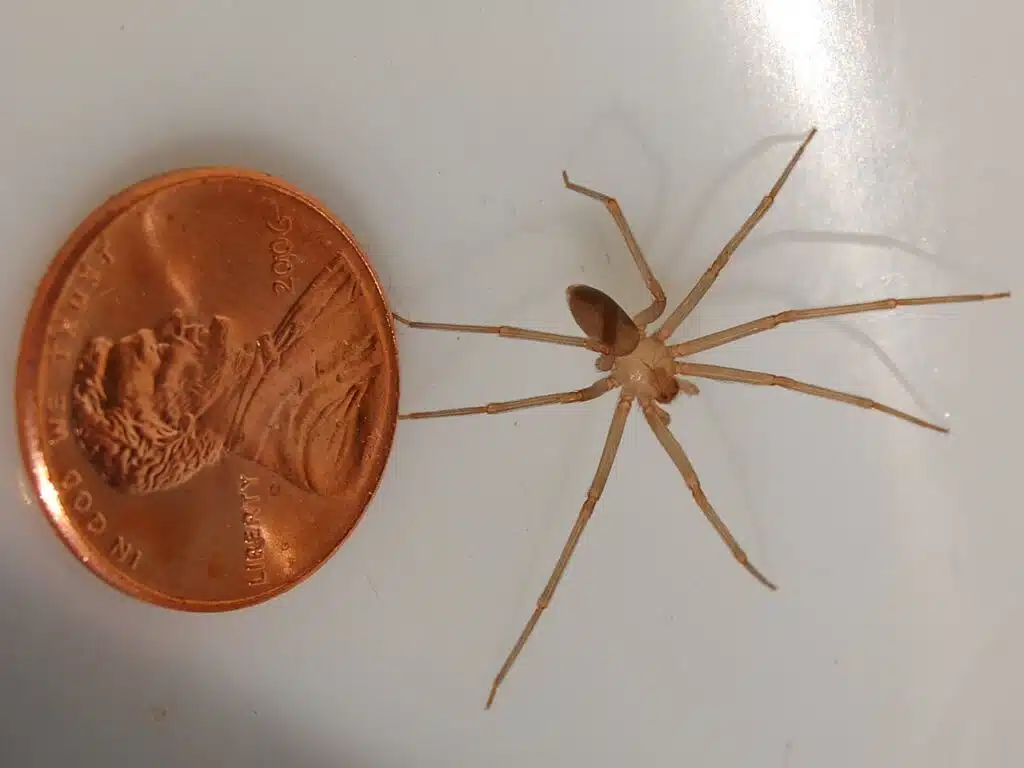
As Southern Black Widows, Brown Recluse Spiders (Loxosceles reclusa) also pose a threat to humans, if they bite.
These spiders have necrotic venom. This means skin necrosis in the area of the bite is typical.
As with Southern Black Widows, not all Brown Recluse spider bites lead to skin necrosis.
It’s only mature Southern Black Widows that are highly venomous while most Brown Recluse spiders don’t lead to necrosis.
Research data suggests only about one-third of Brown Recluse spider bites cause necrosis.
Medical attention might still be required in the case of other symptoms.
It can even take days for the bite to start becoming painful.
Skin necrosis might also occur a few days after a potential Brown Recluse bite.
9. Marbled Orbweaver
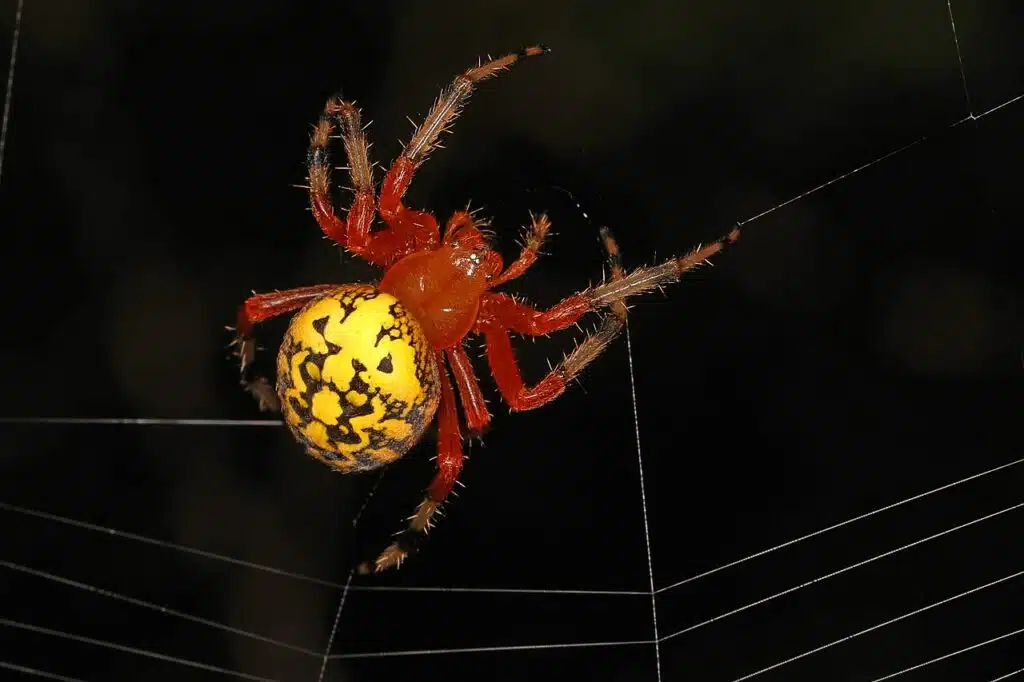
Native to North America and Europe, Marbled Orbweavers (Araneus marmoreus) are a spider species also known as Pumpkin spiders.
This nickname comes from the shape and the orange color of the species.
Marbled Orbweavers like to build large spider webs next to water sources such as streams.
They build all types of small and large webs but are rarely seen on them.
A barely-visible spider silk thread connects these spiders to the spider web.
The spider prefers to lay hidden in a silk cocoon or a leaf nearby and only comes onto its spider web or prey.
This species can be small or large, with a size range between 9 and 20mm.
10. Texas Brown Tarantula
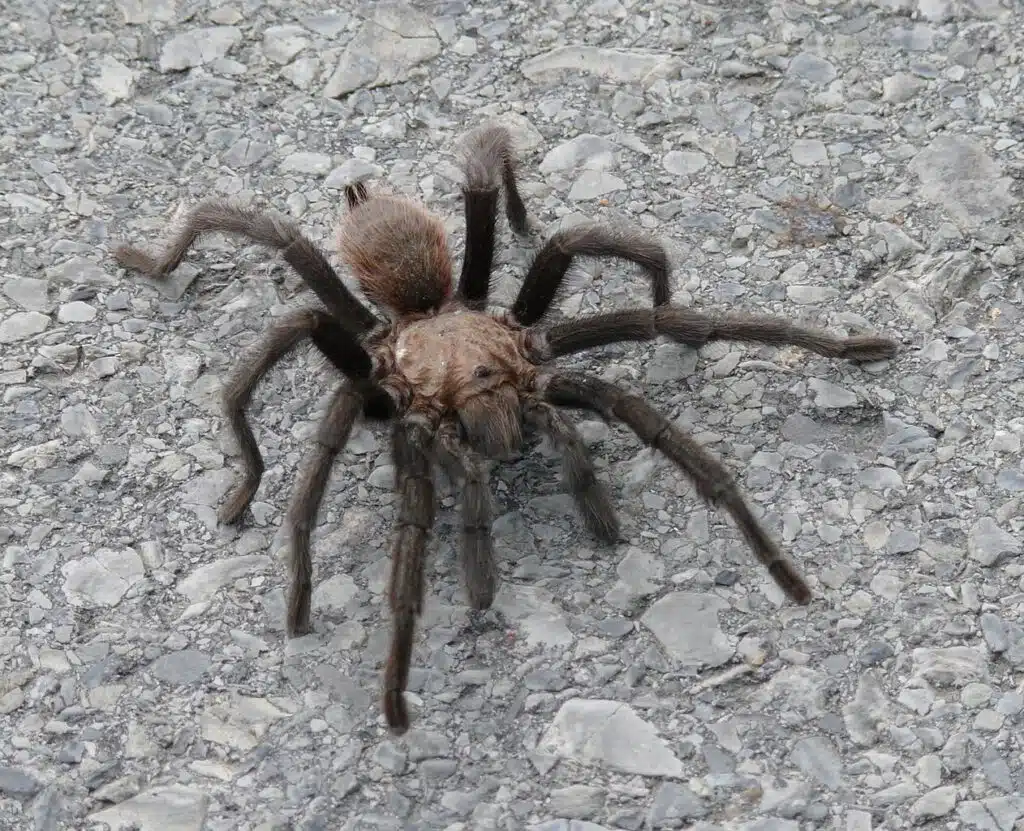
This type of tarantula (Aphonopelma hentzi) has a tan to brown color and can grow to 4 inches.
Bites of the species are normally not harmful to humans.
Texas Brown Tarantulas live in grassy fields and open areas where they seek out hiding spots.
Rodent burrows and other pre-existing shelters are used as a nest. The species blocks them with spider webs to detect passing insects.
These tarantulas can use urticating hairs against their common predators.
11. Rabid Wolf Spider
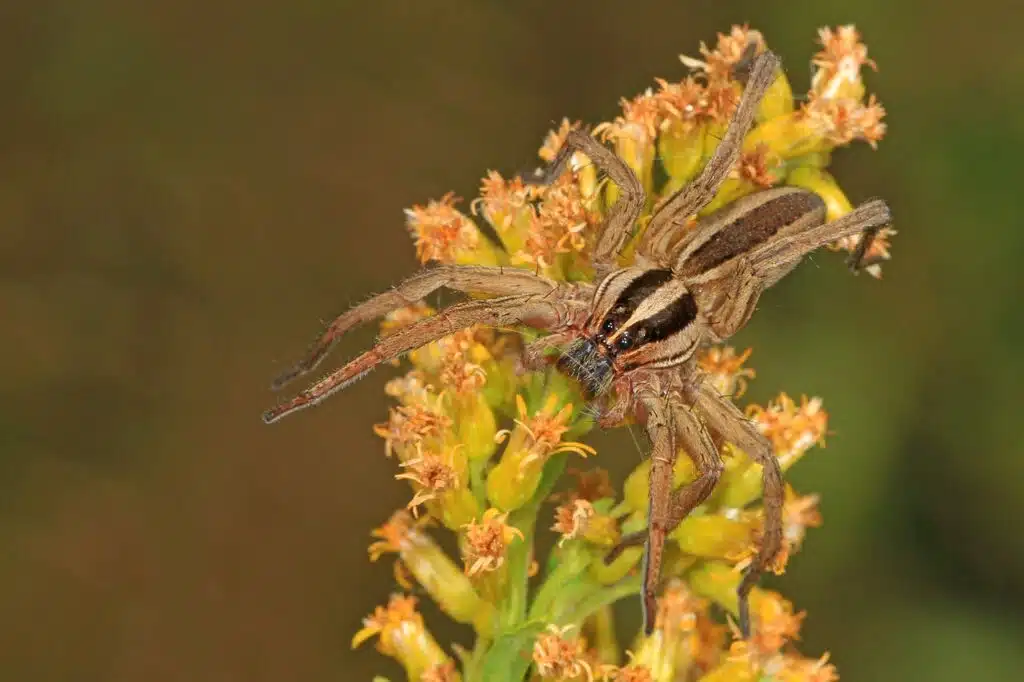
These types of spiders (Rabidosa rabida) have light brown and dark brown colors.
A common sight across all types of dry habitats, Rabid Wolf Spiders are known for having 2 dark brown stripes across the body.
These contrasting stripes make for easy identification.
Rapid and sometimes erratic movements characterize the species. Such moving patterns also inspire the name of the species.
Rabid Wolf Spiders are known predators which move around for bugs and insects.
Grasshoppers are common prey since both species share the same open grassy habitat.
12. American Nursery Web Spider
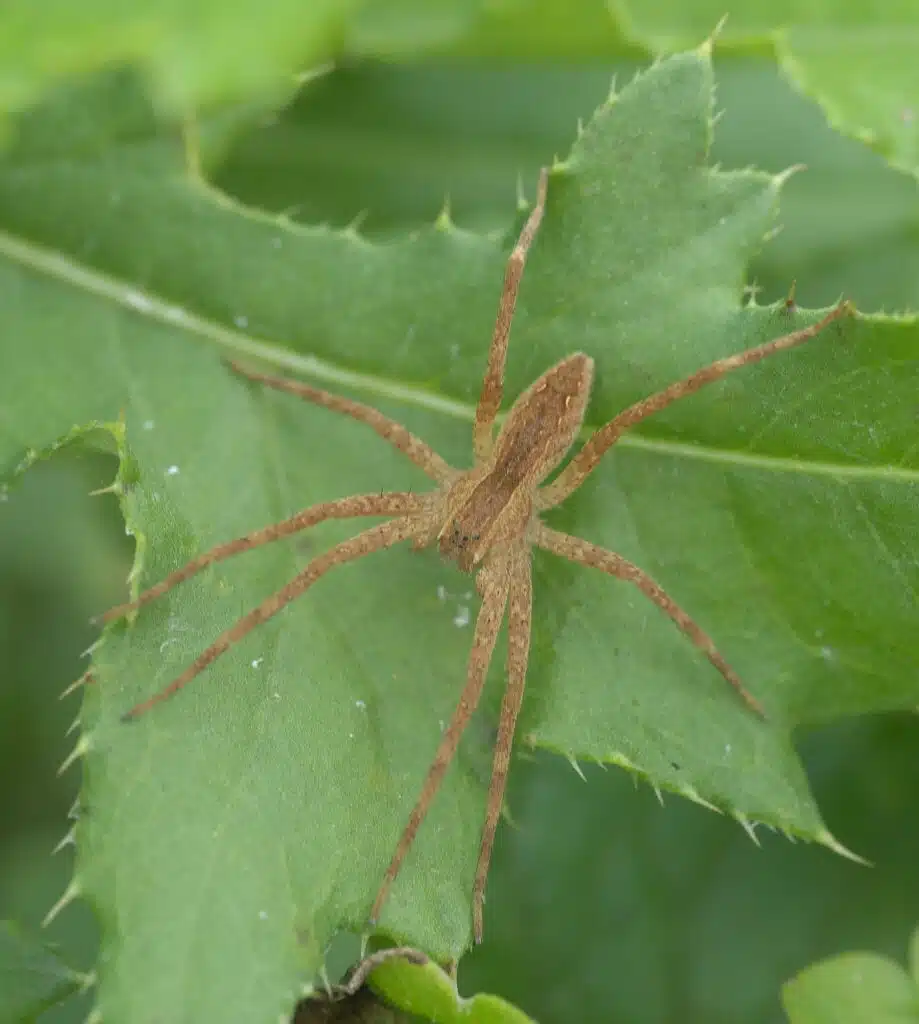
This species of spider (Pisaurina mira) is a common sight around bushes and in short to medium-height vegetation.
Sources of water are often surrounded by vegetation the species likes to live in.
These spiders also like to live in areas between woodlands and plains, including crops where they control possible bug pests.
With an active hunting capacity, these spiders feed on all types of insects that damage legumes or that live next to the water.
13. Arrowhead Orbweaver
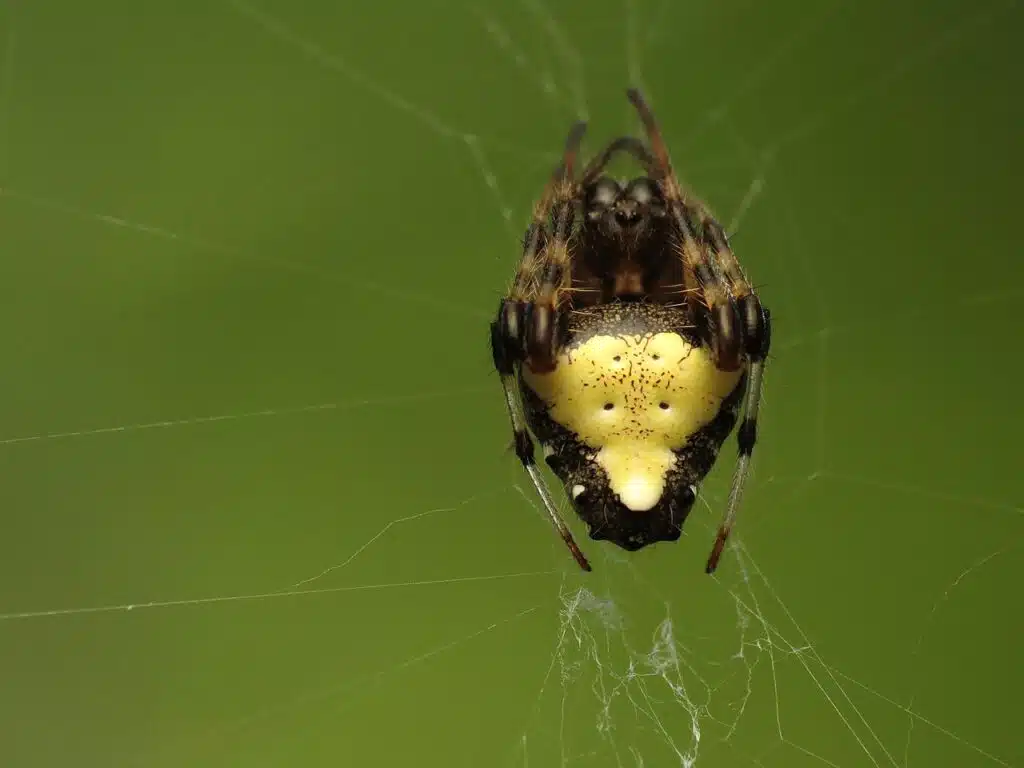
Arrowhead Orbweaver (Verrucosa arenata) likes to live around woodlands and even in human-populated areas.
These spiders stand out from other species by the pointy shape of the body.
Arrow-like triangular abdomen shapes make these spiders different from others.
The triangular section of the abdomen has the same color as the body in males while females have an off-white to cream contrasting color.
This species is also known for building some of the most durable orbweaver spiderwebs.
Insects such as mosquitoes are part of their diet.
14. Dark Fishing Spider
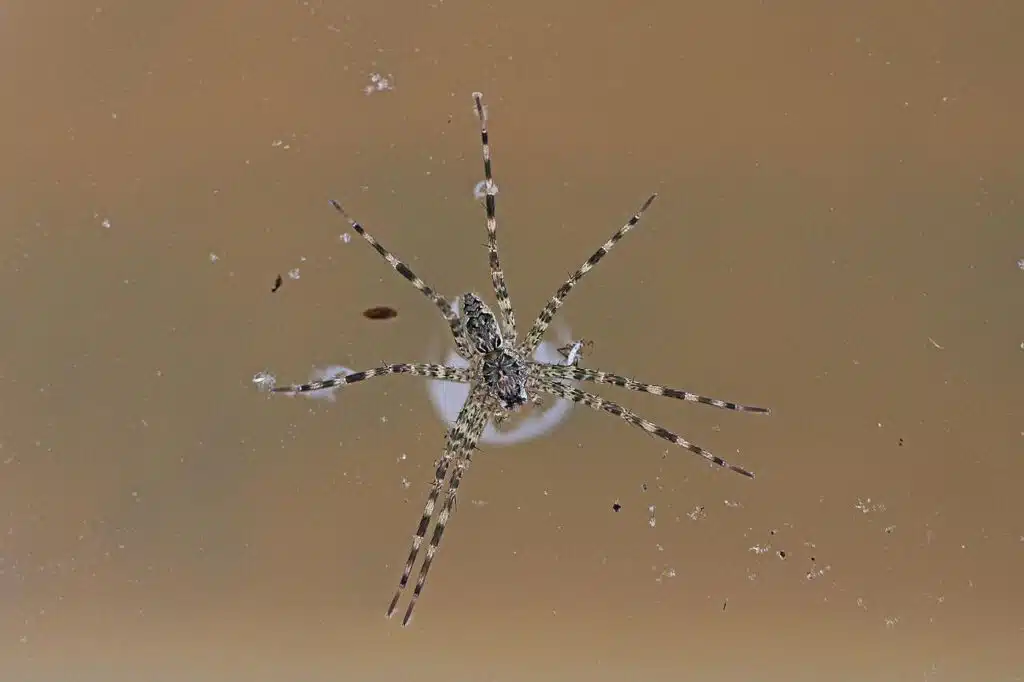
This species (Dolomedes tenebrosus) is named after its habitat. It lives around sources of water but it may also be found in woodlands.
Dark Fishing Spiders have a dark brown color with black marks across its body and legs.
This species measures 7 to 13mm and it’s known for its distinct mating habitats.
The male Dark Fishing Spider dies soon after mating.
Its role is complete when the female eats the male for a kick of nutrition.
Male Dark Fishing Spiders only mate once, as a result. Females mate multiple times in their lifecycles.
15. Spined Micrathena
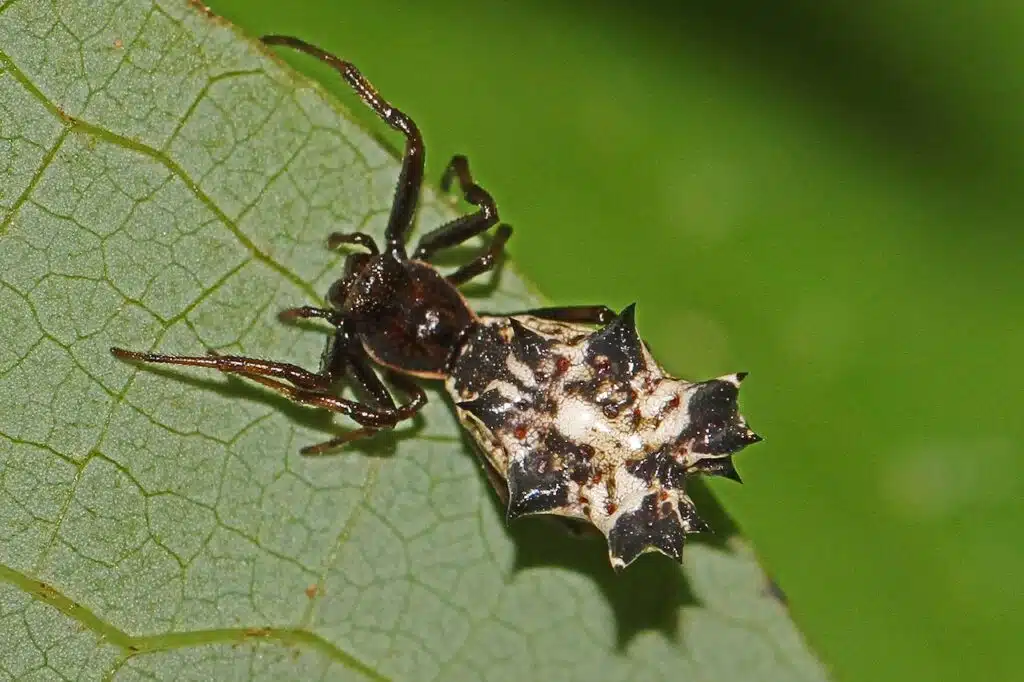
This species (Micrathena gracilis) is found in black and white or in a black morph. Its black-and-white appearance is highly common across the state.
Spined Micrathena spiders can be small, many of them measuring around 5-6mm. Some of the largest Spine Micrathena spiders measure up to 10mm.
Females of the species are known to build spider webs which they guard all the time.
Brown and smaller males don’t build spider webs.
Spiders of this genus are the easiest to spot in late summer when their numbers are the highest.
16. Common House Spider
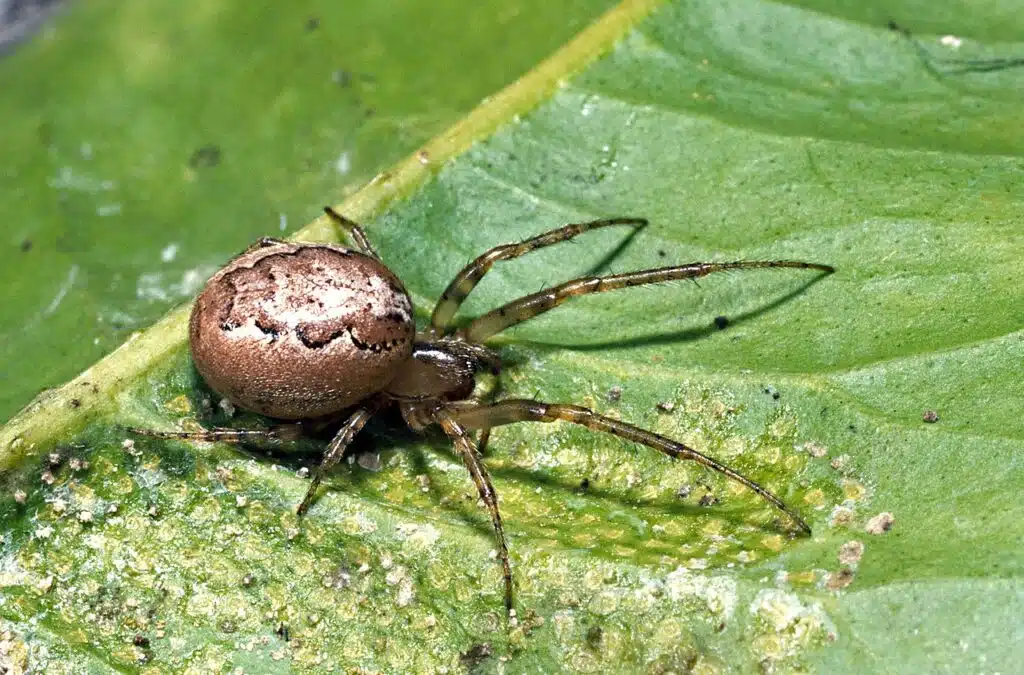
Common House Spiders (Parasteatoda tepidariorum) might look off-putting but they can have a positive role in the ecosystem.
This species feeds on some of the most annoying and common house pests such as mosquitoes, and ants.
They can also feed on some species of venomous predators such as wasps.
Common House Spiders also have plenty of natural predators.
Other species of spiders are considered one of the largest threats to the species.
17. Golden Jumping Spider
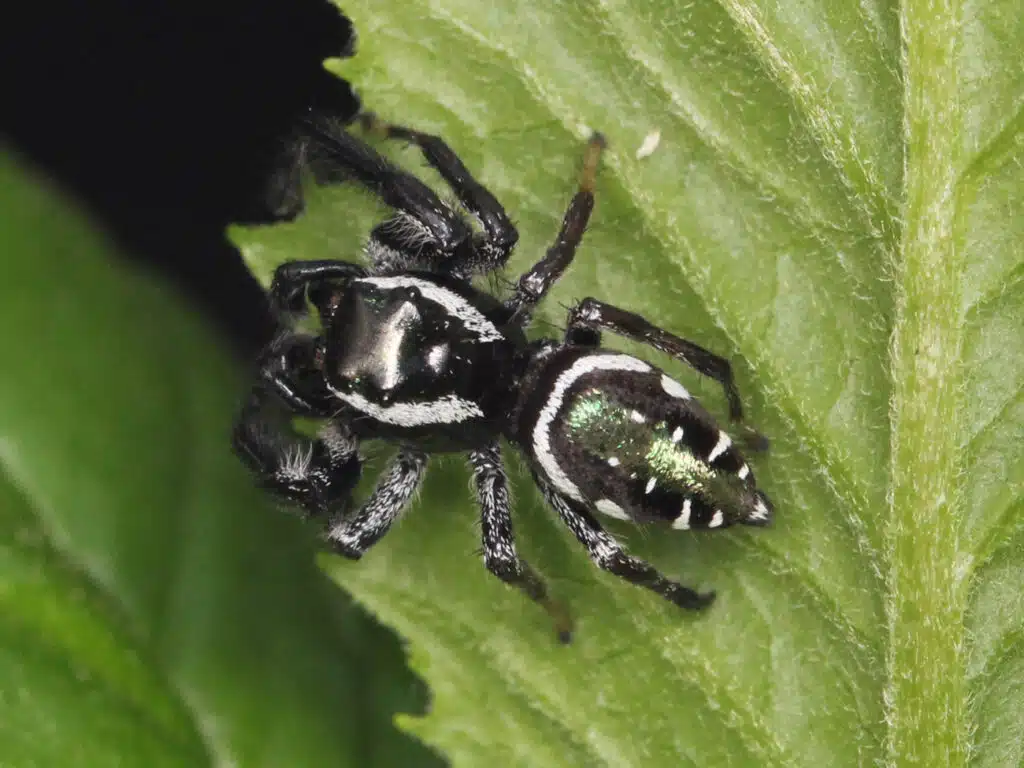
This species of jumping spider (Paraphidippus aurantius) is one of the most colorful across the state.
Visible differences between males and females make for easy gender identification.
Female Golden Jumping Spiders have a metallic green body with orange margins.
Males also have green dorsal coloring, but only as a secondary color to black.
Golden Jumping Spiders move around for prey in areas with low vegetation.
They are the most common in the June-August interval.
18. White-banded Fishing Spider
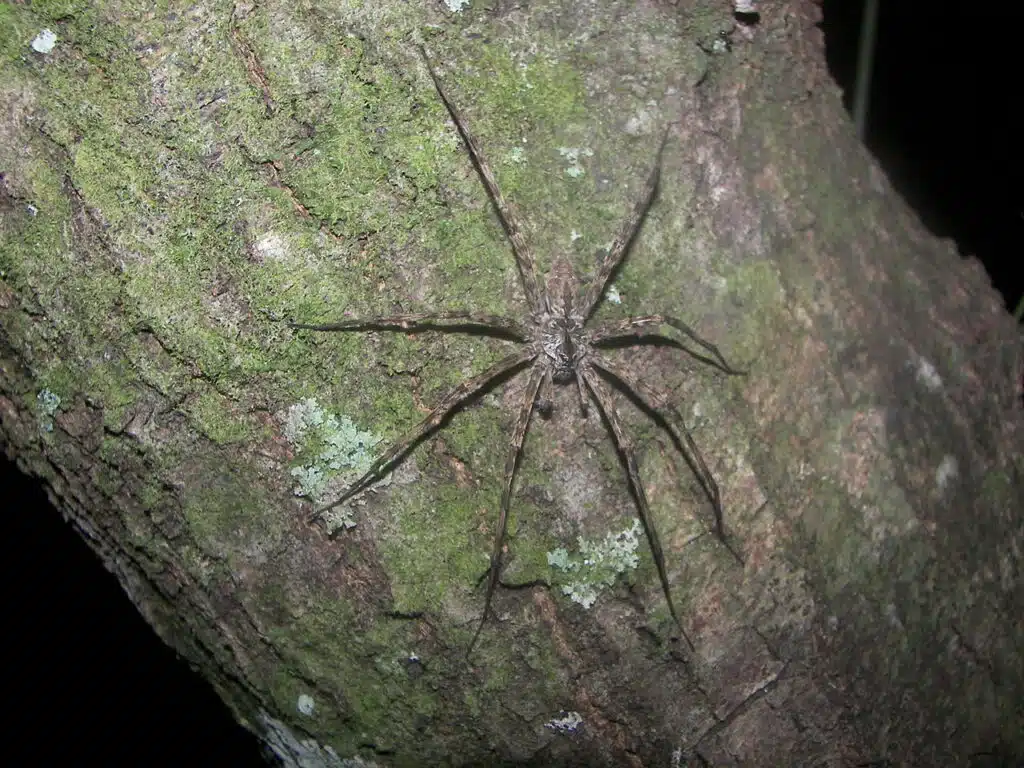
This type of spider (Dolomedes albineus) has an almost white color and it lives in areas close to the water and further away from water.
While an aquatic species, White-banded Fishing Spiders may also be found further out from water sources, especially with reduced food sources.
White-banded Fishing Spiders are among the species known to eat insects that live on water or close to water.
They can eat beetles, flies, mosquitoes, as well as small fish.
19. Furrow Orbweaver
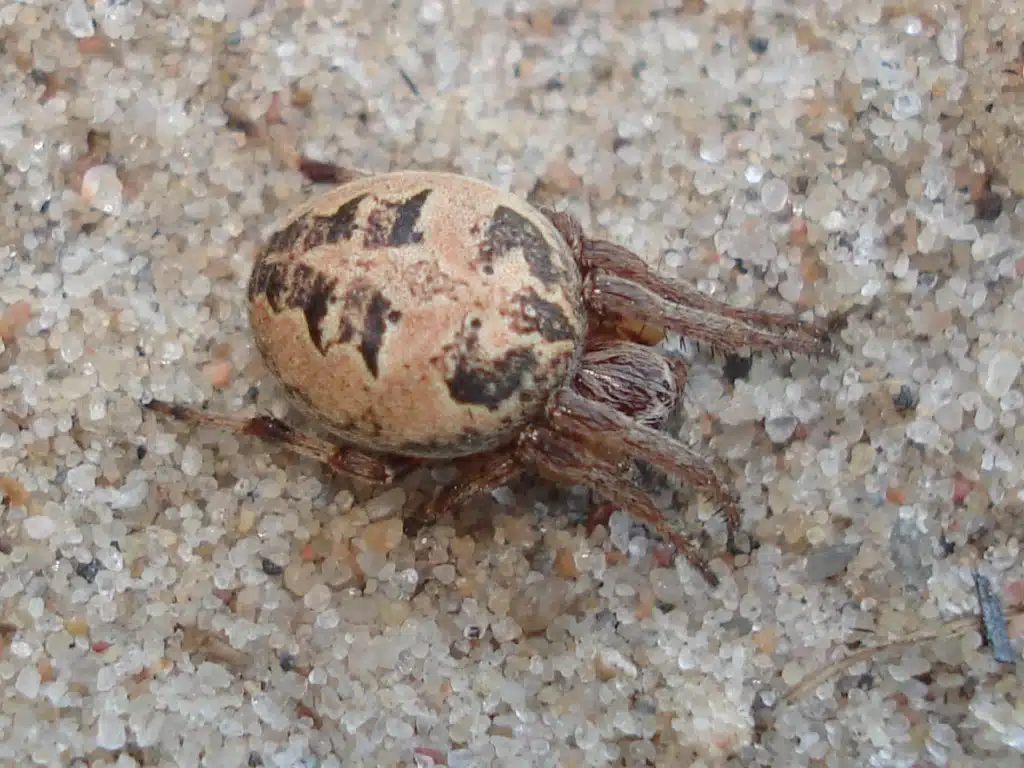
As White-banded Fishing Spiders, Furrow Orbweavers (Larinioides cornutus) are also found next to water sources.
This is a spider species that live in proximity to lakes, vegetation, or man-made structures.
It uses a spider web to trap different types of insects.
Furrow Orbweavers prefer to repair their spider webs at night.
Typical reproductive habitats are noted within the Furrow Orbweaver species.
Male Furrow Orbweavers are among the few spiders that live with the female when mating.
Females are known to initiate the mating process with the capacity to select potential male mates.
20. White-banded Crab Spider
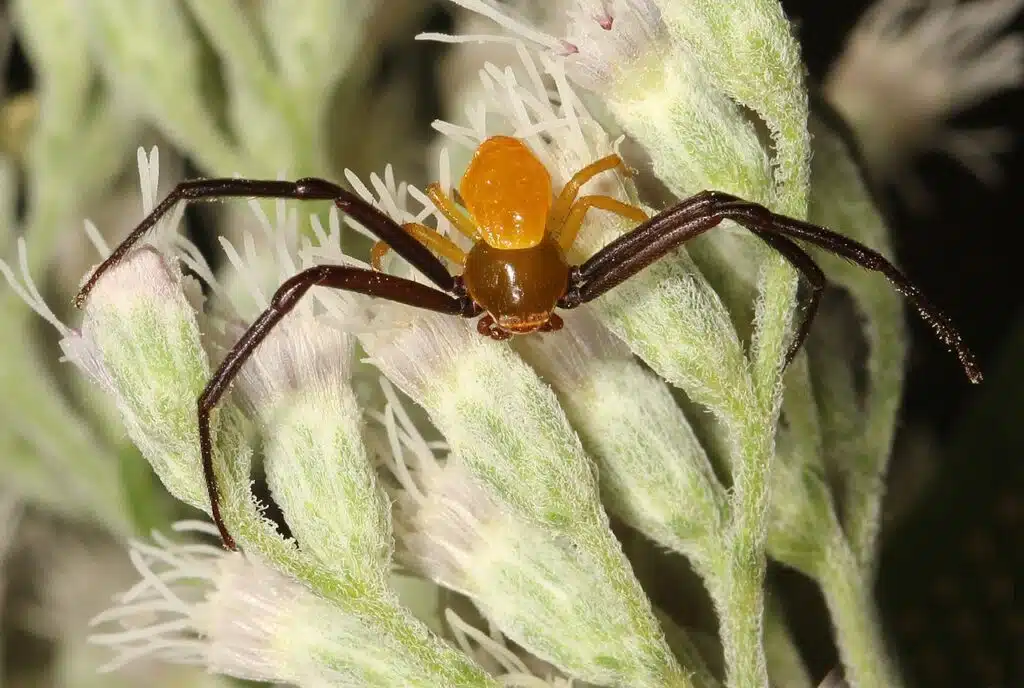
White-banded Crab Spiders (Misumenoides formosipes) are a species known for eating insects that feed on pollen.
Much of the time of the day is spent waiting for these insects on pollen-rich flowers by the species.
Females have a white color which can change to a yellow color, depending on the color of their host flower.
Males have orange abdomens and brown body coloring.
Only female White-banded Crab Spiders can change colors. Females are also 3 times larger than males.
21. Six-spotted Fishing Spider
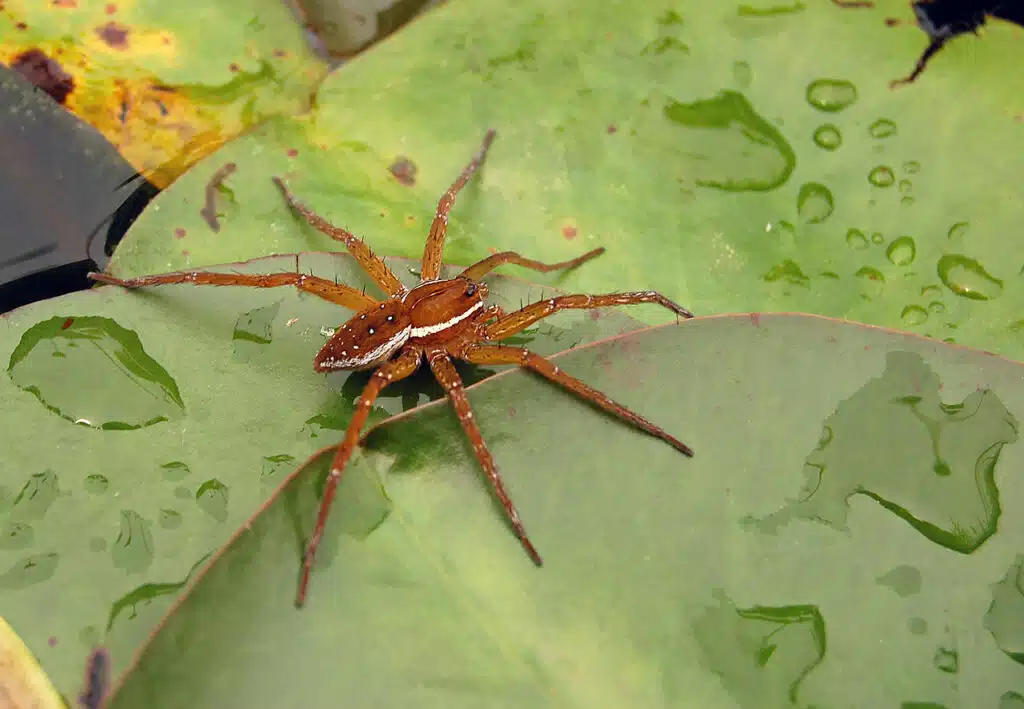
A semi-aquatic nature is specific to the Six-spotted Fishing Spider (Dolomedes triton).
It lives next to water such as lakes and ponds where it feeds on small fish and insects. Six-spotted Fishing Spiders are among the rare species in the state that also eat vertebrates.
This spider might be hard to spot since it remains motionless for most time of the day until it sees prey.
An extreme form of cannibalism is also specific to the female of the species which eats males all the time, not only after mating as other spider species.
Males are a rare sight, as a result.
22. Putnam’s Jumping Spider
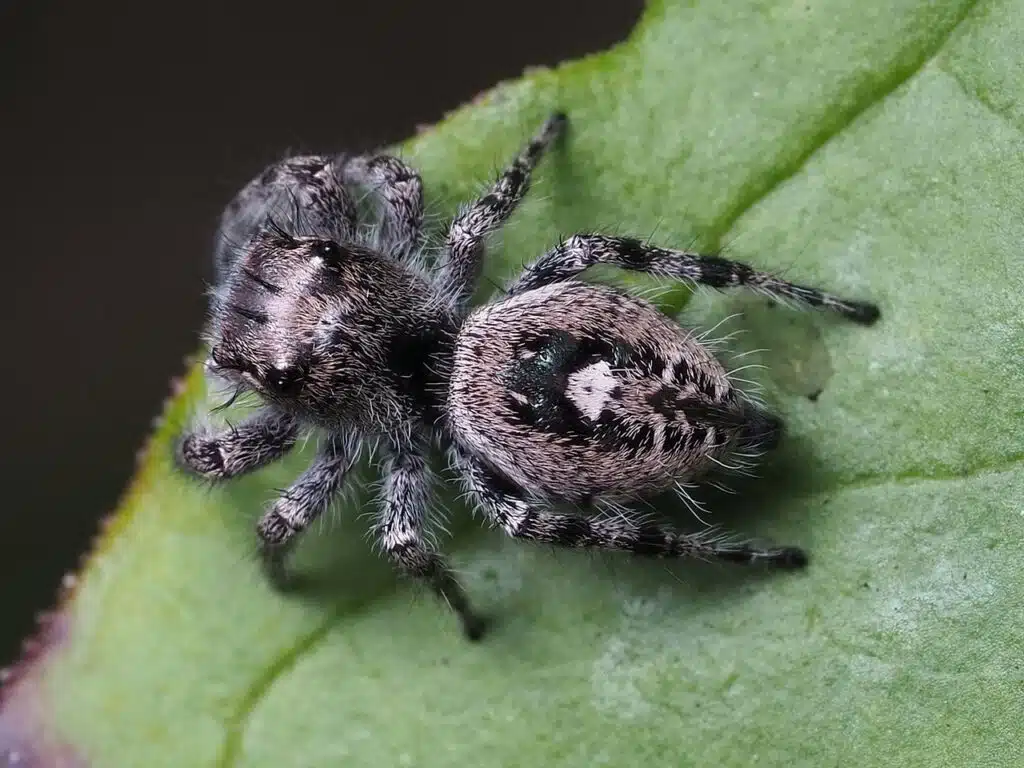
Putnam’s Jumping Spiders (Phidippus putnami) are sometimes found indoors, but they can live in almost any type of dry grassy habitat.
As an active wanderer, it looks for prey by moving around.
Good eyesight is specific to this type of spider.
Known for its hairy body, this dark-colored species has small identification differences between males and females.
Males have black bodies with white marks, grey-to-brown legs, and golden-brown mouthparts.
Females have a lighter color, with brown and gray bodies. Smaller black dorsal sections are seen on the female.
23. Dimorphic Jumping Spider
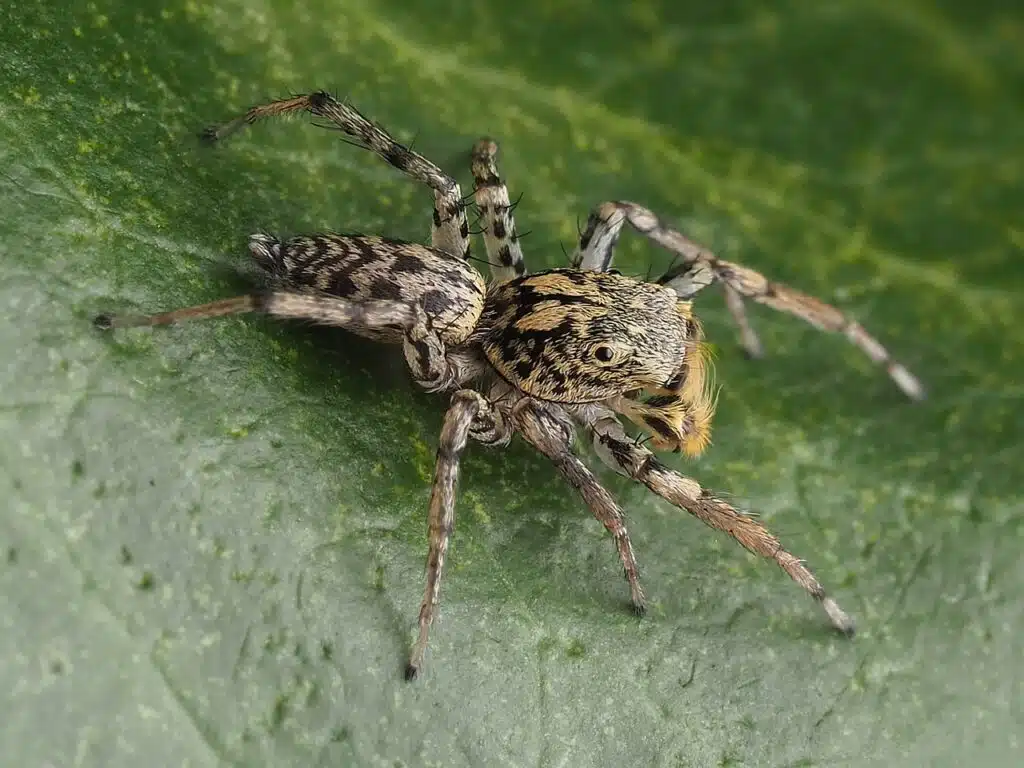
A gray base color with black and white accents is also specific to the Dimorphic Jumping Spider (Maevia inclemens).
Black morphs are also specific to the species. A brown female body can also be black while the gray body of the male also comes in a black morph.
Often seen in gardens, this type of jumping spider eats all types of insects. It even helps reduce crop pests.
Dimorphic Jumping Spiders have also been shown to occasionally feed on pollen, but they don’t have a major pollination role comparable to insects.
24. Long-bodied Cellar Spider
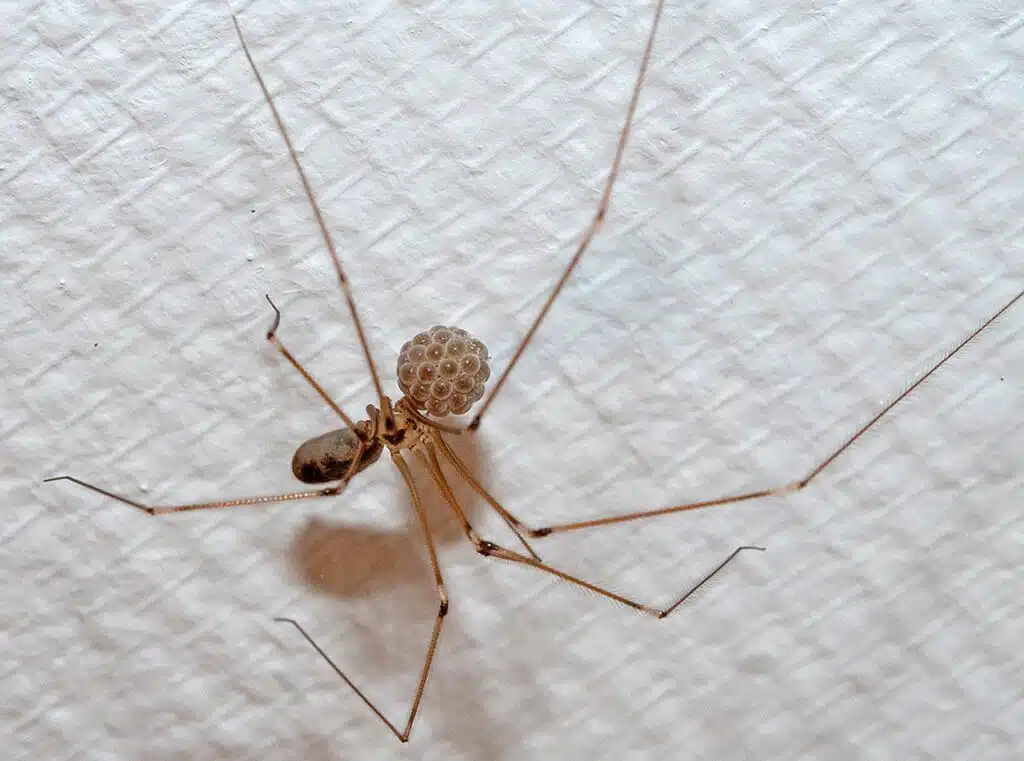
This type of spider (Pholcus phalangioides) is known for its beneficial role when it comes to controlling other types of spiders.
Long-bodied Cellar Spiders can even eat venomous spiders.
People can also get bitten by this spider, but without any reactions as its venom is of no importance to humans.
Silk, on the other hand, is how important to humans. Research shows its silk contains anti-bacterial agents which could potentially be used in treating infectious diseases.
This species is known to build spider webs but it may also freely move around without relying on its web to catch insects.
It uses mimicry tactics to lure in potential insects before grabbing them from a close distance.
25. Sylvan Jumping Spider
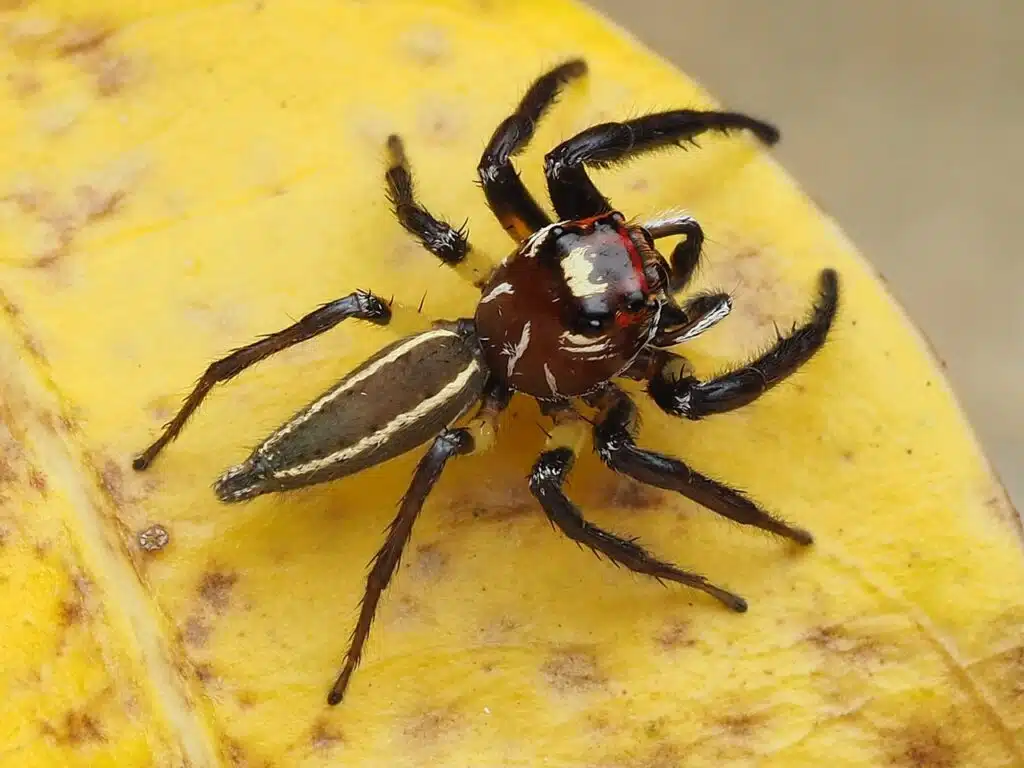
This type of jumping spider (Colonus sylvanus) is characterized by its small size. It grows to a size of up to 7mm and it has coloring differences between males and females.
Males are always darker, typically black, with contrasting white abdominal stripes.
The female is cream, white, off-white, or light gray with white stripes and large brown eyes.
Its diet is comprised of insects, but it also feeds on pollen on occasion.
26. Arrow-shaped Orbweaver
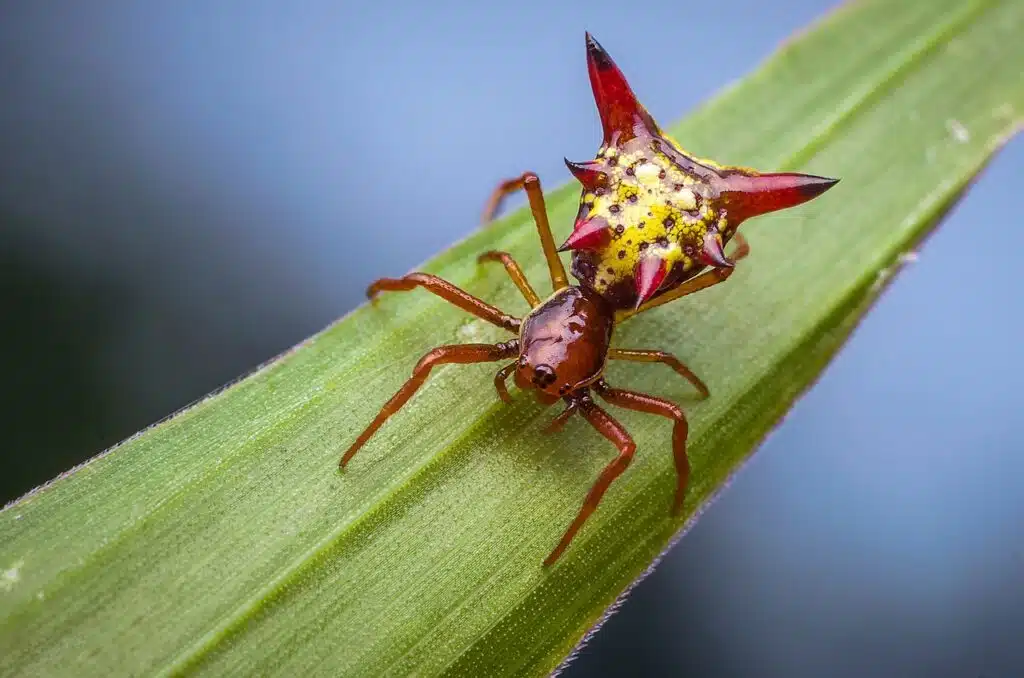
An arrow-shaped abdomen inspires the name of this spider species (Micrathena sagittata).
Males are a rare sight when it comes to Arrow-shaped Orbweavers.
Females, on the other hand, are seen in gardens, woodlands, and around crops.
A contrasting red-brown and yellow color is specific to the females of the species which have a positive role in the ecosystem.
Females build spider webs to trap and eat flying insects and a few other detrimental species such as leafhoppers.
Stronger and larger females are known to eat males soon after mating.
27. American Green Crab Spider
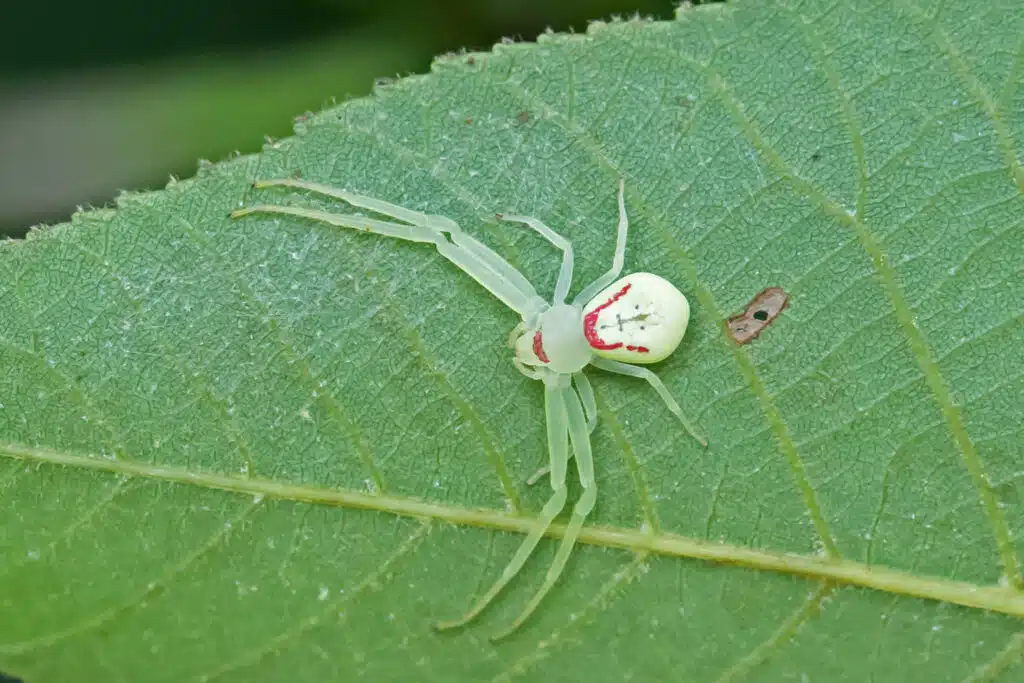
This type of spider (Misumessus oblongus) is known for its bright color that appears white.
As a crab spider, the species can move sideways similar to crabs.
Unlike other spiders, long pairs of front legs make these movements possible.
This species moves around for prey, typically in woodlands and in open fields next to woodlands.
It only uses silk to lay eggs. Male American Green Crab Spiders use silk to tie up the female which would otherwise eat them while mating.
Male spiders are a few times smaller than females.
28. Georgia Wolf Spider
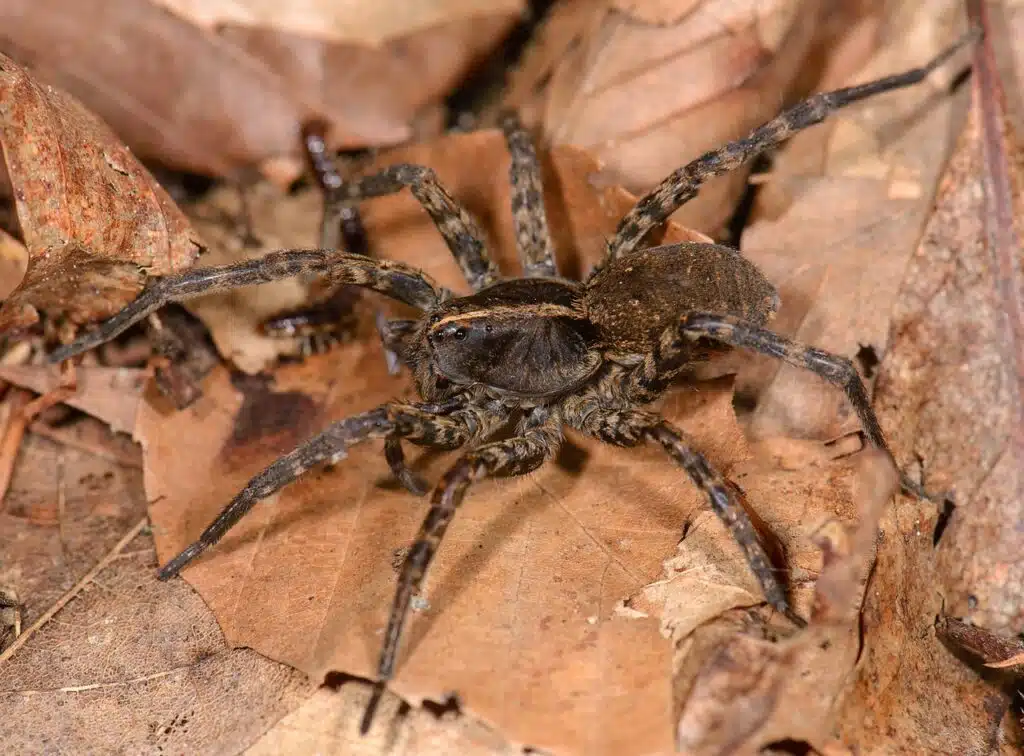
This species (Tigrosa georgicola) has a dark color with black sections across its legs and body.
A bright stripe is seen on the central dorsal side of the cephalothorax.
Difficult to spot on leaf litter, this is a species of spider common in woodlands. While diurnal, this wolf spider is still out of sight for many as it prefers to run when it sees humans.
Georgia Wolf Spiders might be larger, but their occasional bite isn’t venomous or highly painful.
29. Wetland Giant Wolf Spider
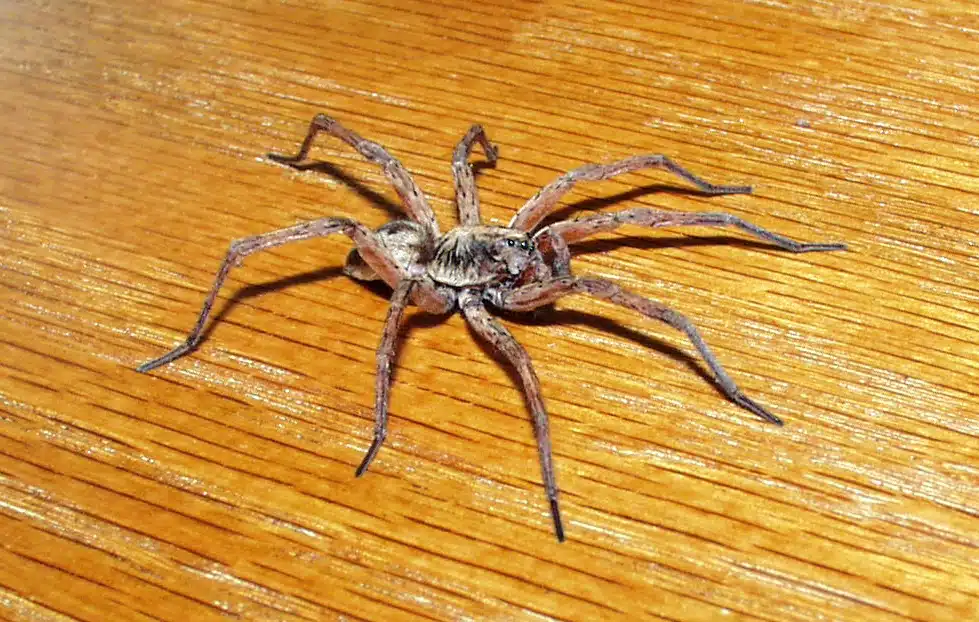
This dark yellow spider has brown and black nuances across its body.
The species (Tigrosa helluo) is known for being venomous, but not to humans. Its bites can be painful, but don’t require medical attention unless there’s a type of allergic reaction.
Spiders of this genus are known to be dimorphic. Females are considerably larger than males.
Sexual cannibalism is also specific to these spiders.
Females eat males soon after mating. The larger the size difference between females and males the more likely it is for the male to be eaten.
30. Northern Black Widow
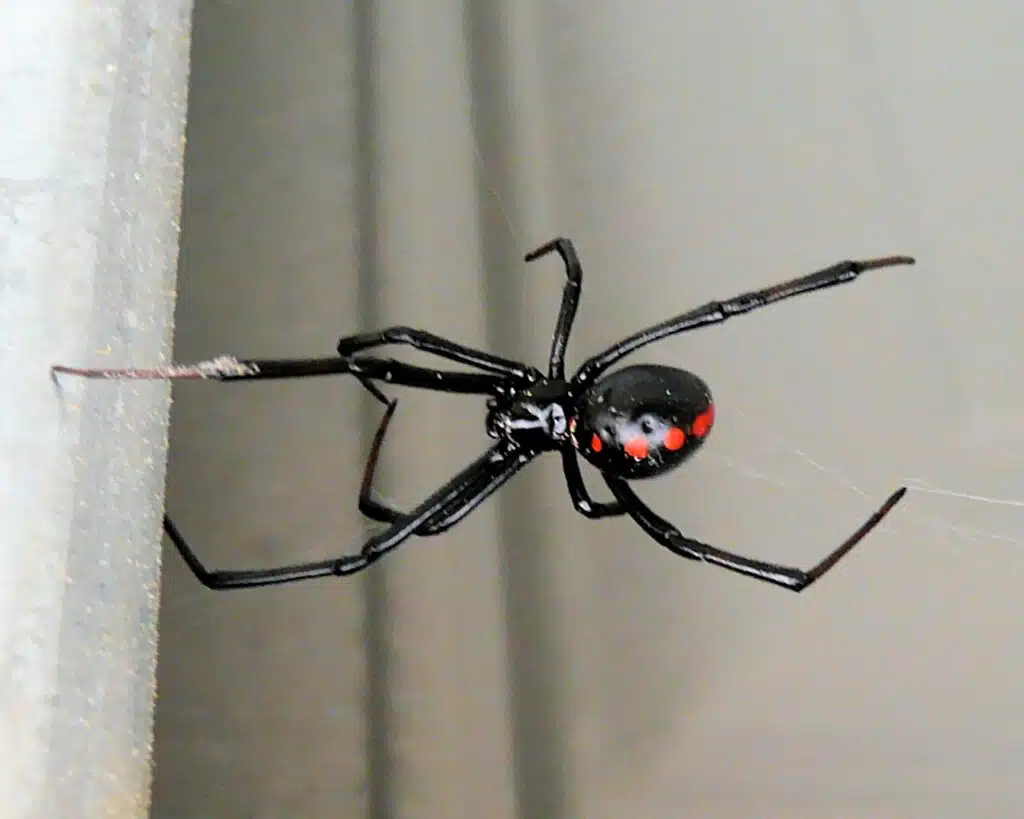
Northern Black Widows (Latrodectus variolus) can sometimes be seen across the state. This is one of the most venomous species in the state.
Affecting the nervous system, the venom of the species can cause different effects.
Most bites aren’t life-threatening, even if children and seniors might need urgent medical care.
Northern Black Widows have a black body with a 2-part or a split red hourglass marking on the ventral abdomen.